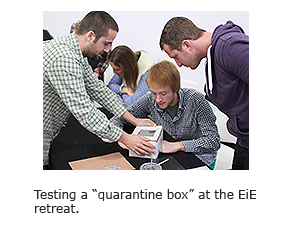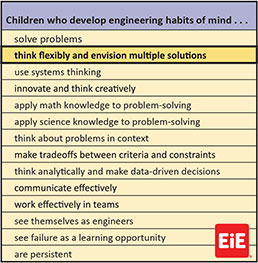
Retreats give us a chance to test new engineering activities that we might include in our curricula. This time, we tried out a biomedical engineering design challenge for Engineering Everywhere, our afterschool curriculum for middle-schoolers.
The challenge was timely considering that the Ebola outbreak was making headlines: Design a sealed “glove box” (quarantine box)--a device used in biomedical research to confine contagious microbes. A successfully designed box would allow for the transfer of a sample of “deadly virus” (actually, harmless glow-in-the-dark powder) from one vial to another while keeping ALL the powder inside the box, avoiding contaminating the “lab” (our conference room).
We broke into small groups. Each group got a shoebox, a couple of surgical  gloves, two vials, some tape, a length of plastic wrap, and other craft materials.
gloves, two vials, some tape, a length of plastic wrap, and other craft materials.
I remember thinking that the choice of materials didn’t leave much room for innovation—just punch holes in the box and anchor the gloves so you can reach inside. But after the teams finished designing, we did a “gallery walk,” so everyone could see what others had created. I was astonished to see no two glove boxes were even remotely alike.
Engineering design challenges are by nature open-ended. You have to meet the criteria (for example, “the box must be sealed so virus doesn’t get out”) and you have to keep within the constraints (each team was allowed just one 2-foot piece of tape), but there’s still room for creativity and multiple solutions.
Historically, schools haven’t offered students much experience with open-ended problems. Instead there’s been an emphasis on getting the “right” answer. But that outlook is changing, with new evidence that open-ended problems build a child’s problem-solving abilities better than experiences with single-solution problems.
We’ve specifically designed EiE to offer open ended challenges—and we find that young children are very creative! This short video provides an example. You see a first-grade teacher in Minnesota reflecting on the different ways her students designed a device for pollinating flower by hand while working on the EiE unit “Best of Bugs.”
The ability to generate multiple solution can help students succeed in every academic field, not just science and engineering. And as students grow up and enter the world of work, almost every career you can think of--from hairdressing to health care to holding elected office and more--the ability to think flexibly and consider multiple solutions is a valuable, if not essential skill.
Engineering is Elementary is a project of the National Center for Technological Literacy at the Museum of Science, Boston.








